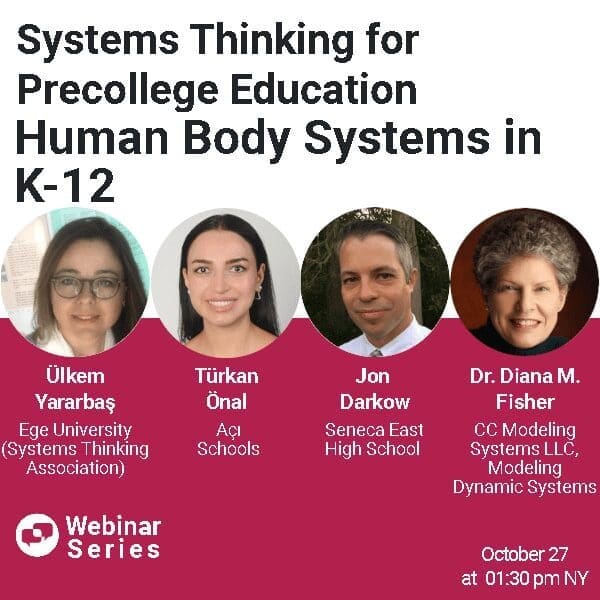Members are now able to add their System Dynamics-related events to the Society calendar
for greater engagement and visibility. Not a member? Join here.

- This event has passed.
Human Body Systems in K-12
October 27, 2022 @ 1:30 pm - 2:30 pm EDT

How Sweet Is Sugar?Obesity, although being preventable, is currently a global epidemic. According to the World Health Organization’s data worldwide obesity has nearly tripled since 1975. Since obesity and sugar consumption are closely linked, we aimed to design an activity plan using SD/ST tools on dietary sugar consumption in 2015. Since then the activity is updated every year and became a two- week program including more than ten activities. In this presentation we want to introduce the main parts of this activity plan. |
||
Human Body SystemsSince life needs energy, all living things contain various mechanisms that transfer energy to their cells to survive. We used system thinking in the 6th Grade Science Curriculum to teach how the human body systems work, including digestive, circulatory, respiratory, urination and defecation. Conceptual and numerical models were used in the lesson plans and learning materials by using SD/ST tools. Lesson plans were implemented in Darussafaka Middle School during the 2021-22 Academic Year. It will be updated and used in the new academic year. In this presentation, we would like to share the design of the lessons and learning materials related to six human body systems. |
||
HPV and Adaptive ImmunityThe human papillomavirus (HPV) is one of the most commonly transmitted sexually transmitted diseases which can lead to high rates of cervical and other cancers in infected individuals. The Gardasil vaccine prevents HPV infections. Students use the HPV and Adaptive Immunity simulation I created to understand how the adaptive immune system works to produce antibodies and the importance of vaccines in preventing and transmitting infectious diseases. Students compare the accumulation of antibodies in the blood after an HPV infection to understand the immune response. Additionally, students identify the positive and negative feedback loops in the model. The goal of the model is to help students understand the importance of being vaccinated to prevent the spread of HPV and the cancers it can generate.
|
||
Glucose-Insulin HomeostasisA lesson about glucose and insulin homeostasis was used with three high school Anatomy and Physiology classes. The lesson incorporated systems thinking and system dynamics (SD) tools. The presentation will highlight the sequence of the lesson and show several versions of the SD model. This classroom lesson was facilitated by Diana Fisher and Ed Gallaher. It was one lesson of four dealing with homeostasis that was used with the A&P students. The other three lessons involved body temperature regulation, calcium homeostasis, and the homeostatic response due to decrease in oxygen in red blood cells. |







